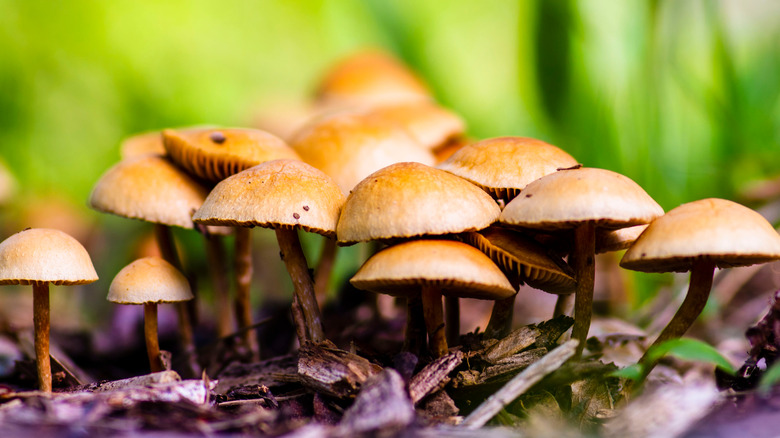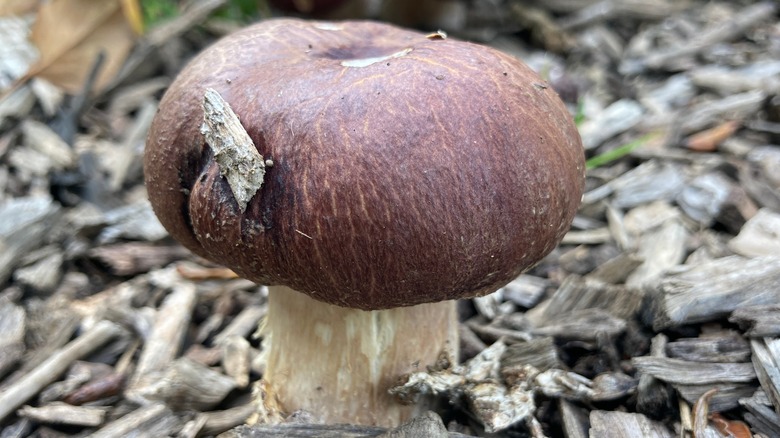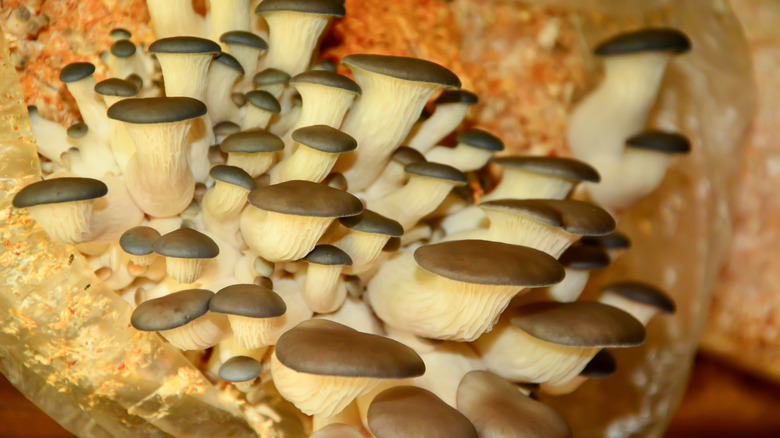The Best Kinds Of Wood Mulch For Growing Mushrooms
Finding an edible wild mushroom peeking out of the earth is a thrill. However, with so many poisonous varieties growing in natural spaces, it's best to limit your thrill to raising them at home. Being certain that you're starting with a safe strain eliminates risk and focuses the fun on encouraging the mushrooms to appear. Growing mushrooms at home is becoming more popular by the day, whether it's outside on a pile of woodchips or inside using this secret ingredient that will help you grow them at home. Indoor or out, wood mulches, like hardwood chips or sawdust, are versatile homes for your hopeful spores.
With light, humidity, temperatures, and growing medium all playing a role in whether your shiitakes will appear, sourcing the best wood mulch to grow your spores in will increase your chances of securing a fruitful harvest. Among the easiest methods for growing mushrooms is doing so in beds outdoors, and most wood-loving 'shrooms take beautifully to hardwood mulch. However, sawdust is a plentiful resource to layer into wood chip beds for growing some mushrooms. What's more, utilizing sawdust blocks may be the perfect method for bringing your mushroom garden indoors.
Hardwood chips are tops for outdoor growing
Wood chip mulches tend to be the go-to for growing mushrooms in outdoor beds, and fresh chips are ideal–since they will be less likely to house other fungi that will compete with your crop for nutrients. Made up of layered hardwood chips and spores, a shaded outdoor mushroom bed is a low-maintenance way to grow high-reward fungi, including ones that are often costly or hard to find in grocery stores.
The most prized mushrooms are snobs for hardwood, and wine caps and shiitakes are some of the easiest varieties that take to the hardwood chips. Wine caps, tasty giants with caps that can grow as large as dinner plates, do best on poplar and aspen chips, preferably from healthy, live trees or branches that were cut within a few weeks. Flavorful and meaty shiitakes are considered easy to cultivate too. Although they're usually grown on logs, they will also flourish in oak wood chips. If you have limited yard space, hardwood-loving spores can grow heartily in the shade of flowers in ornamental plots. While there are pros and cons of using wood bark as mulch in the garden, a layer of hardwood bark in your flower bed will give it double duty as a spot for growing mushrooms.
Make use of sawdust
Whether from hardwoods or softwoods like conifers, sawdust makes a simple and cheap breeding ground for many delectable mushrooms. When home growers purchase spores, called 'spawn,' they are mixed with hardwood sawdust before being layered with other materials in a bed. Many mushroom varieties do well with a bit of sawdust mixed into their beds–beyond just what their spawn came in. You can buy growing medium mixes that contain the perfect ratios of ingredients for optimal results. While hardwoods are the top choice for wine caps, they also appreciate a mix that includes no more than 50% pine sawdust. You can get sawdust from local sawmills, but make sure it only comes from wood that hasn't been chemically treated for your safety.
Once the cooler seasons set in, sawdust blocks allow you to continue growing indoors. These bricks of wood particles, also called supplemented sawdust blocks, contain organic materials that give a nutrient boost to your crop. They don't take up much space, and when used for indoor growing, your mushrooms are less likely to come into contact with contaminants while feasting on the healthy mix of sawdust and nitrogen-rich material. Beech mushrooms, among 15 mushroom varieties you can grow at home, are a prime option for indoor growing on sawdust.


